 |
A symbol that haunts plans for the reconstruction of ground zero: the National Cash Register Pavilion, by Ely Jacques Kahn and Walter Dorin Teague, at the New York World's Fair of 1939. Photo: Museum of the City of New York. |
4 March 2002. Seven photographs taken today added.
2 March 2002
Source: Hardcopy The New York Times, March 3, 2002
Online: http://www.nytimes.com/2002/03/03/arts/design/03MUSC.html
Herbert Muschamp
Herbert Muschamp is architecture critic of the New York Times.
As Italians say at election time, piazza pulita! -- let's clean up the square! The clearing of ground zero has proceeded much faster than expected, and it is not too soon to think, about cleaning up the politics of redeveloping the site. Indeed, the 16-acre property is now a zone of convergence for our top two national crises: 9/11 and Enron. Architecture is a cultural medium in which this convergence will be conspicuously manifested.
Secrecy and accountability: these are the two issues the convergence has raised. They are, of course, at odds. The status quo relies on secrecy to retain and enlarge power. ("Trust us; we're reliable.") In this sense, the climate of emergency fostered by the war on terrorism has been a godsend for every status quo. ("Certain things we can't talk about.") By the same token, the collapse of Enron threatens every status quo. It exposes secrecy as the currency that enables people and institutions to evade responsibility for their actions.
How much accountability can we stand? How willing or eager are we to be kept in the dark? How, much ethical compromise does it take to keep the world from falling apart? And who gets to arbitrate such contentious issues, particularly in the cultural sphere? Like it or not, ground zero has become a theater where these questions will be played out.
Over time, writers will probe every facet of the political, cultural and economic forces now jostling over places on the stage. For now, it may suffice to say: We are watching you! History will be judging you! If decisionmakers treat this project as no more than a local exercise in economic development, goosed up by fatuous public relations, they will be weighed in the scales and found wanting, for as long as history sustains a regard for truth.
In fact, the moving hand has already begun to inscribe some fairly lurid writing on the walls. Within days of the terrorist attacks, as the recovery of bodies from the towering wreckage was barely under way, ground zero was officially declared a construction site. This declaration was the direct cause of the scuffle between police officers and firefighters in November, when the latter group sought access to the ground where many of their colleagues had lost their lives.
This wasn't just a technicality. It announced not only that construction would go forward, but also that the site was officially privatized. You and I and the entire rest of the world might suppose that, by dint of cataclysm, we all might have a stake in this piece of property, but that was our problem. Rudolph Giuliani had declared that we must think like capitalists, not communists. Take that, comrades!
Obnoxious as the mayor's statement was, at least it placed the city on notice that a giant cash register had already materialized within the smoke. Why bother with a design competition? We could just build four stretch versions of the iconic National Cash Register Pavilion from the 1939 World's Fair. Nice Art Deco lines. Reduced to miniature size, it would make a fine piggy-bank souvenir. Ka-ching!
 |
A symbol that haunts plans for the reconstruction of ground zero: the National Cash Register Pavilion, by Ely Jacques Kahn and Walter Dorin Teague, at the New York World's Fair of 1939. Photo: Museum of the City of New York. |
The acceptance of ground zero as a construction site began filtering into the media when the observation platform went up on Trinity Place. Visitors to ground zero deserved "something more than" a construction site, it was said. Never mind that no one was actually going there to see something they didn't even recognize as a construction site. Never mind that building construction is one of the great spectacles of Manhattan, or that few buildings are even remotely as interesting when completed as they are in construction. Usually, "something more" turns out to be immensely less.
In any case, as conceived by its designers, the platform was never intended for conventional sidewalk superintendents. It was meant to offer a vantage point on history, as it unfolded in real time. That history included the buildings that had stood there, among them those before the Twin Towers were built; the towers themselves and their destruction; the spectacle of clearing the site; fantasies about its future; and the hardening of fantasy into implementation. Above all, what people wanted to see was a site of military aggression. Not a battlefield, perhaps, but certainly a field of slaughter, (in fact, members of the Architectural History Foundation have proposed that Congress declare ground zero a historic battlefield and place it under federal supervision, whether or not it is commercially developed.)
Metaphorically, the platform serves the ideal of public oversight: the idea that public officials should be held accountable for their actions. By extension, the design signifies the idea that the public should be more assertive in holding officials accountable. Oversight, we should keep in mind, is not a passive occupation but a means of engaging with power.
Other commentators accused the platform of converting ground zero into a tourist attraction, as if it were a ride at Disney World. This remark should not be casually dismissed. In fact, it touches on a deeper truth than the commentators may have realized. The relationship between warfare and tourism is one of the open secrets of modern life. It was the topic of "Back to the Front: Tourisms of War," a 1994 book edited by two of the platform's designers, Elizabeth Diller and Ricardo Scofidio, who have been exploring the subject for years.
The development of battle sites as tourist attractions; the dependence of tourism on technology invented for military purposes the similarity of war and tourism as instruments for the penetration of national borders: "See the World." See the World Trade Center. Architecture is not just the visual forms of buildings but also the cultural relationships they reflect.
In short, criticisms of the platform have degraded history, language and thought. Or, rather, they reflect the, degree to which thought is routinely degraded by market values. This is not the same as economic corruption. And we would all naturally go into hiding should Congress open hearings on the corruption of ideas. Nonetheless, for those who haven't given up hope that the redevelopment of lower Manhattan will rise to a sense of historical occasion, cultural corruption is not a minor detail.
Real estate speculation in New York is governed by a concept called the "public-private partnership." In forthcoming columns, I will examine the workings of this concept as it applies to ground zero and to the agencies, private firms and civic and professional groups involved with the decisionmaking process. Here, I'll confine myself to sketching its general contour.
Public-private partnerships are an outgrowth of privatization. Typically, the private sector provides planning and design services along with capital investment. The public sector provides permits and assists with land acquisition and zoning interpretation. It may also require developers to provide improvements in the public interest, including parks and recreational areas; remodeled subway stations; and community centers, health clinics and other nonprofit services,
The public-private partnership has replaced the centralized model of city planning adopted during the Depression, and is generally regarded as an improvement on that model, or at least as less likely to produce the homogeneous, towers-in-a-park formula associated with low-income housing projects that proliferated in the postwar decades. It has been embraced here as an example of the so-called "third way," through which the public sector seeks to unburden itself from the costs and defects of the welfare state by elevating the social responsibility of private enterprise.
BATTERY PARK CITY and the redevelopment of 42nd Street are ambitious examples of public-private partnerships, though the concept is routinely applied as well in the development of individual buildings, including the future headquarters of The New York Times. It's fair to say that the concept is as good as the ideas driving its particular application. Its greatest strength, perhaps, is its capacity to try out new ideas -- to take risks and to learn from shortcomings as they materialize. Its greatest weakness is its tendency to curb public oversight by restricting access to the decisionmaking process.
By virtue of the powers invested in the newly created Lower Manhattan Development Authority, the rebuilding of the financial district will be the most important public-private development partnership in the city's history. Its domain is not limited to ground zero, but penetrates into surround, ing neighborhoods as far north as Chambers Street. Quite apart from the historical magnitude of the events that led to its creation, the Authority has the power to transform the public face of Manhattan for future generations.
What ideas, if any, will drive the transformation? Where will the ideas come from? How and why will some ideas come to ba preferred over others? And who will bold the decisionmakers accountable? To what extent, and in what form, should public oversight penetrate behind closed doors?
The pivotal issue here is that of boundaries. A public-private partnership is an economic and cultural ecotone -- an area of overlap between the public and private spheres. In nature an ecotone can support life forms not found in its adjacent ecosystems. It can develop vibrant new structures of life. An ecotone may also foster new species of predators, however, including some with remarkable camouflage. In architecture, as in power companies, their eating habits deserve close observation.
The following photographs taken on February 25, 2002 (except as noted), show a mix of the public observation platform, public memorials, temporary facilities and construction activity at the WTC.
Photos by Cryptome. Analog (with date) and digital.
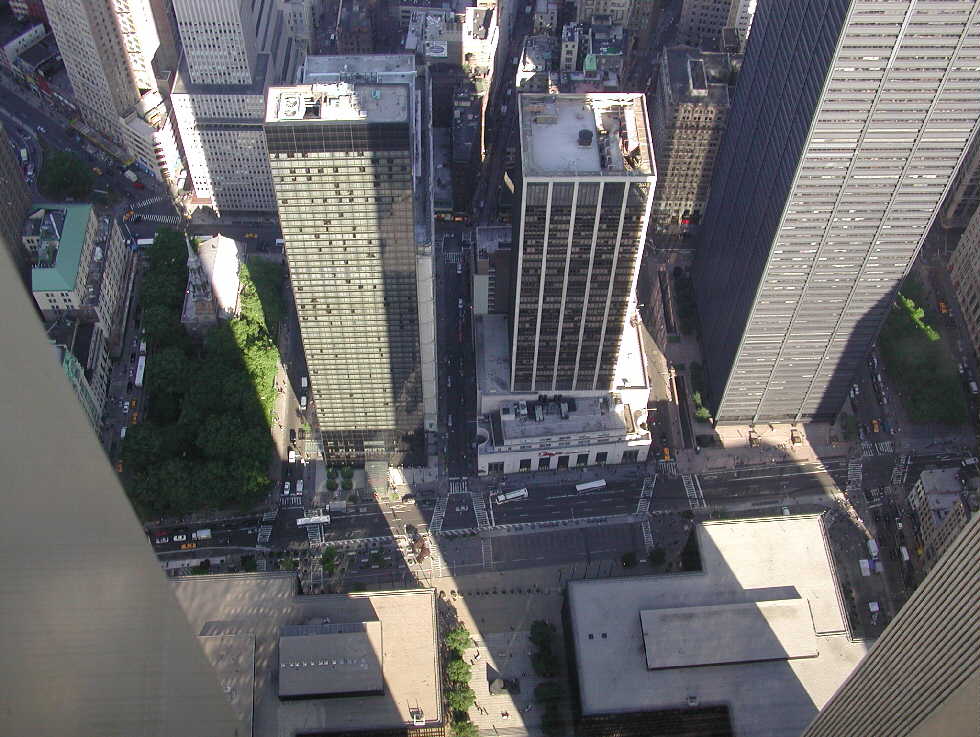
May 31, 2001. Photo from Windows on the World Restaurant, 106th Floor of WTC North Tower, looking down and east to Church Street. Sunlight between the two towers lights the Millennium Hotel and trees around St. Paul's Chapel. The observation platform shown below was constructed along the street between the hotel and chapel. Map of area: http://nunce.org/wtc/wtc-map2.jpg
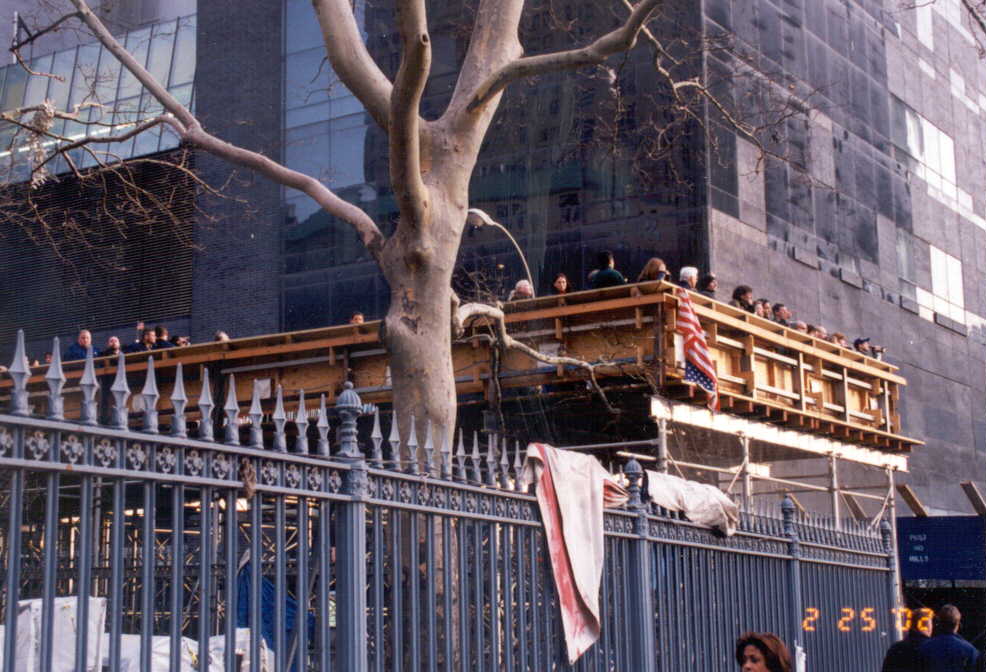
Public observation platform adjoining St. Paul's Chapel and its graveyard, overlooking WTC and Church Street, looking southeast.

Public observation platform, from Church Street; Millennium Hotel in background with plywood installed in curtain wall, looking southeast.

Covered grave stones in St. Paul's Chapel graveyard, observation platform access ramp in background, looking southeast.
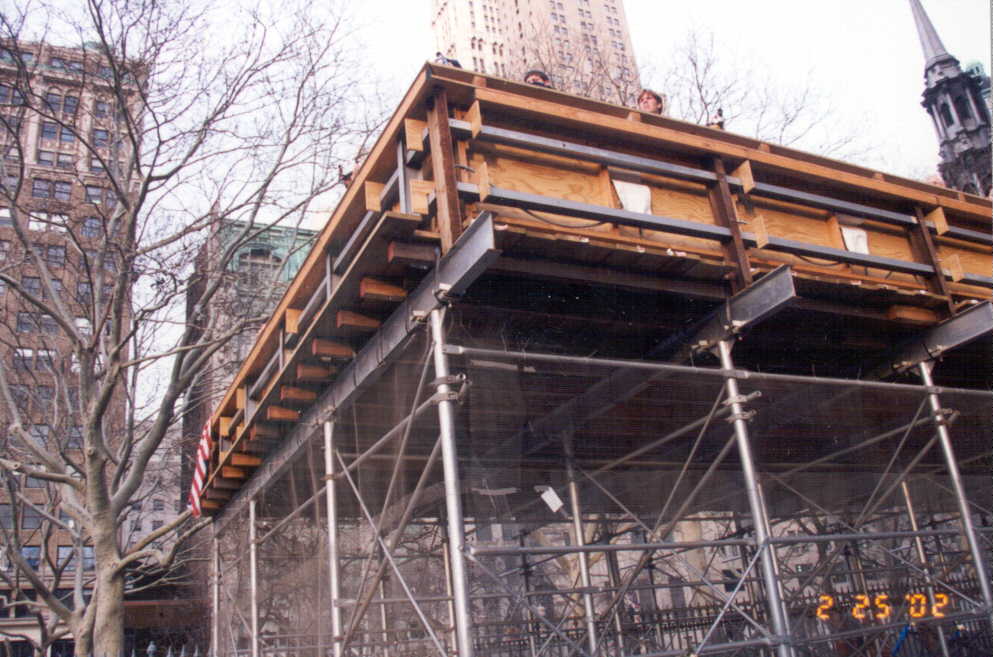
Observation viewing platform, from Church Sreet sidewalk, looking northeast.
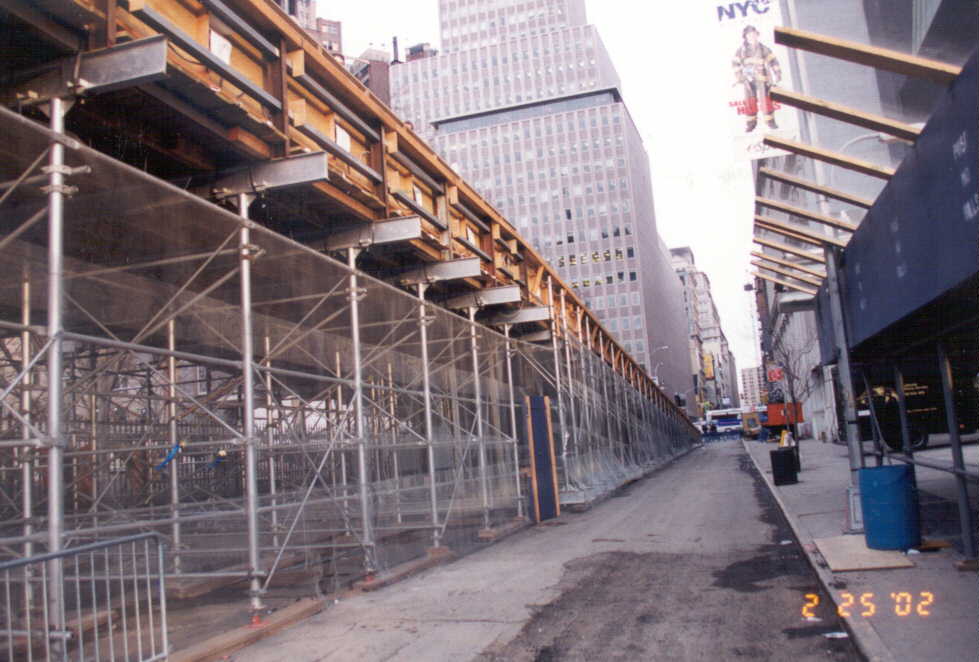
Observation viewing platform access ramp, from Church Sreet, looking east.
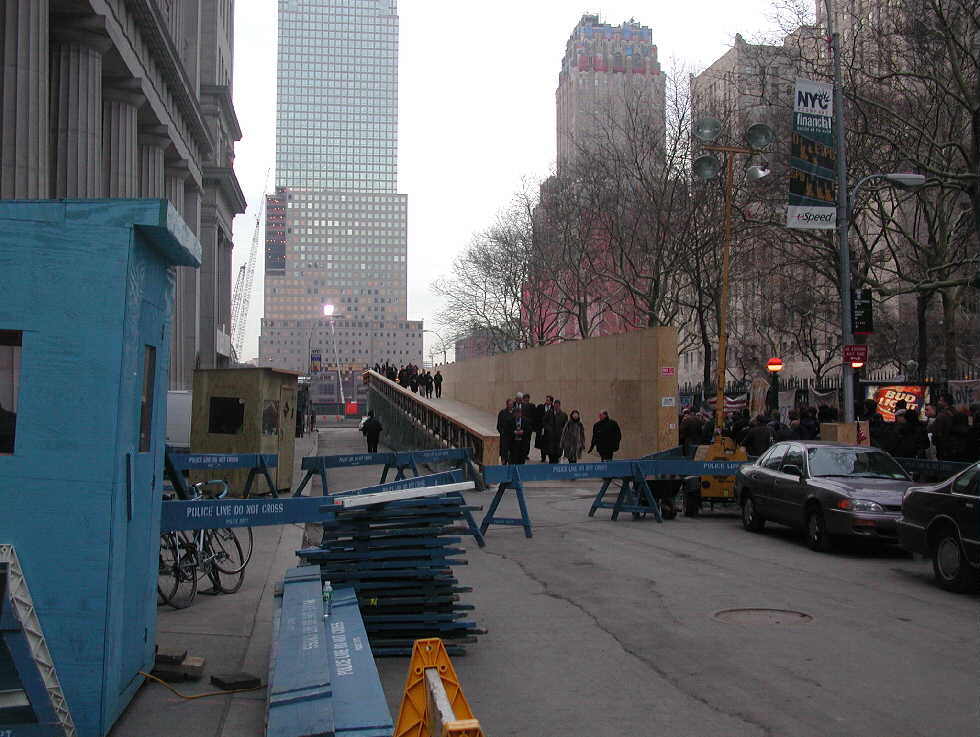
January 14, 2002. Observation platform access ramp from entrance side; American Express tower in background.
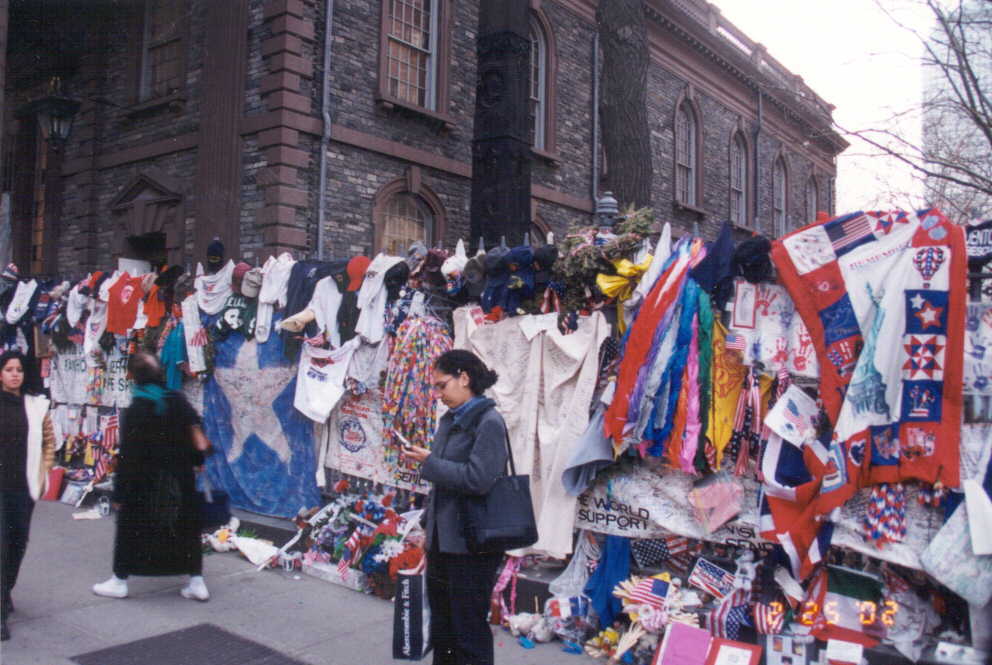
Memorials in front of St. Paul's Chapel, on Broadway sidewalk, looking west.

Memorials in front of St. Paul's Chapel, on Broadway sidewalk, looking south.
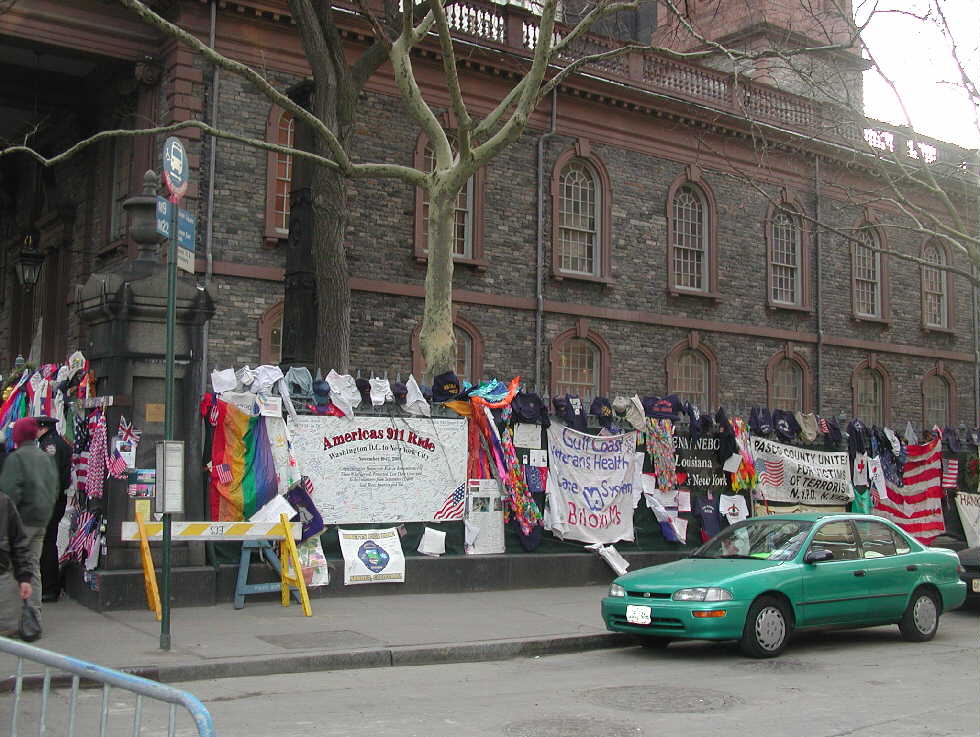
Memorials along the fence of St. Paul's Chapel, Vesey Street sidewalk, looking southwest.
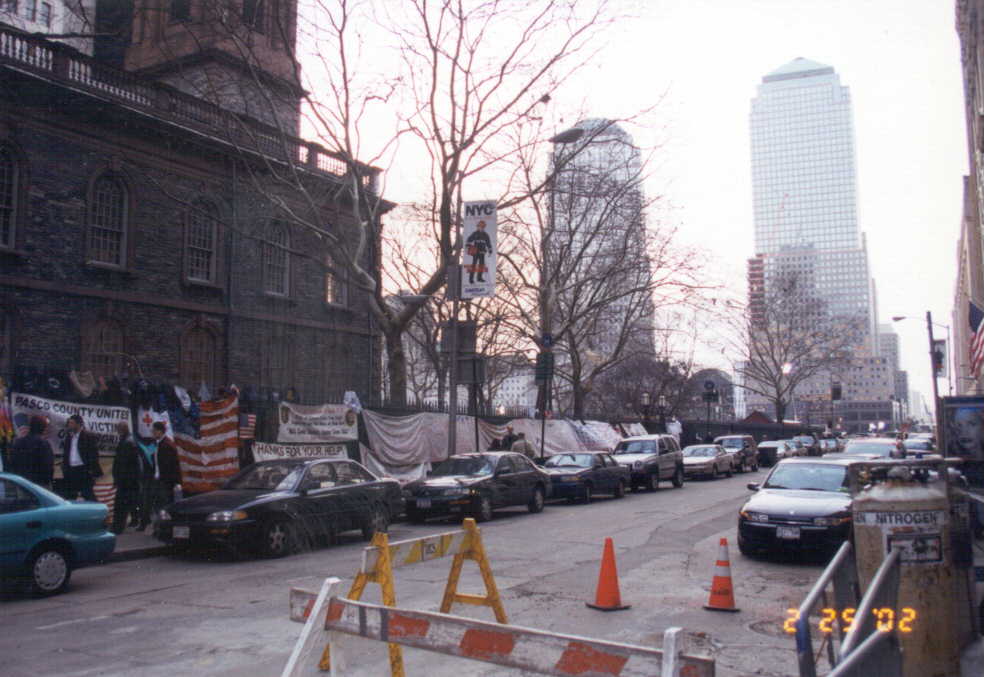
Memorials along the fence of St. Paul's Chapel, Vesey Street sidewalk, looking southwest; American Express tower at right background.
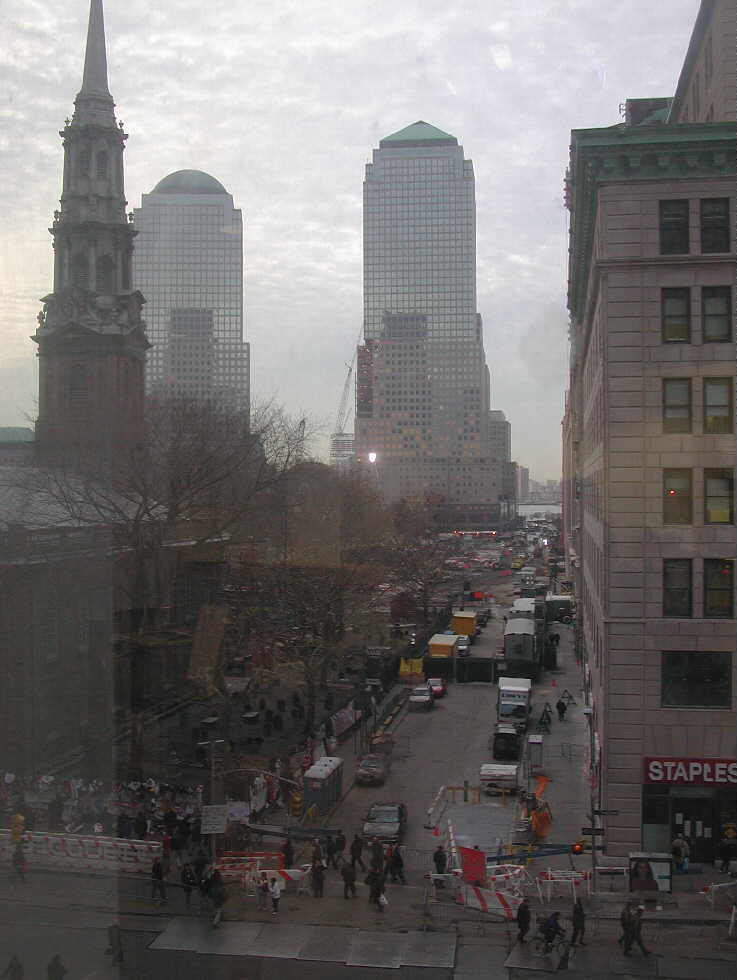
January 14, 2002. Looking west along Vesey Street, through glass window. Barricades in place at Broadway, Church Street one block west parallel to Broadway.

Temporary construction trailers along WTC site excavation, opposite observation platform across Church Street, looking southwest.
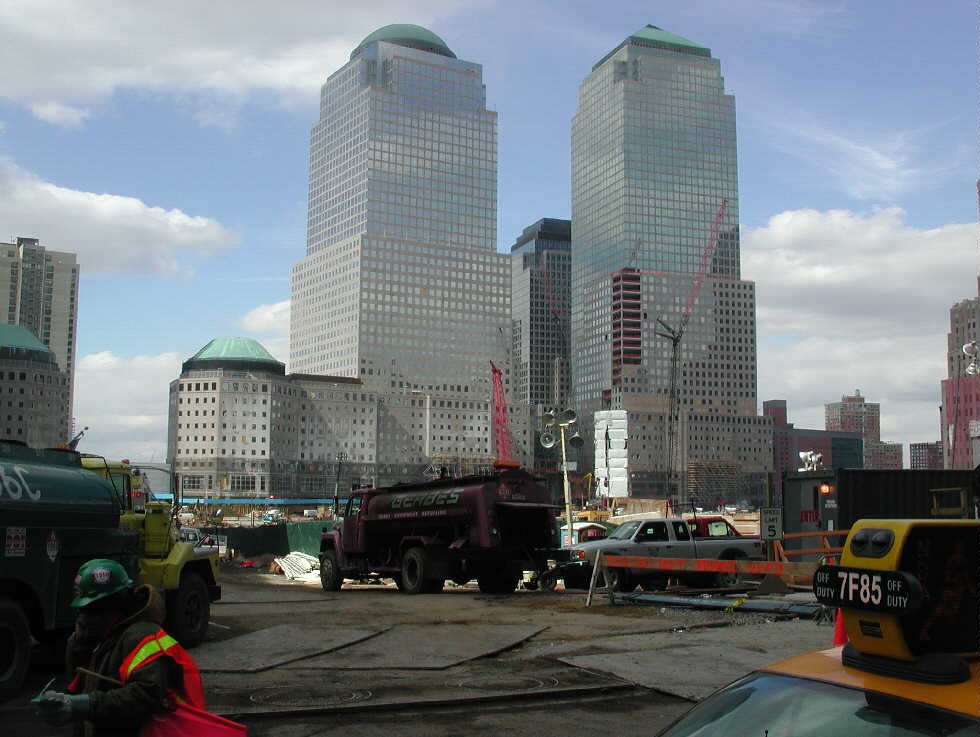
4 March 2002. Entrance to WTC recovery and construction site, looking west from Church Street. American Express building under repair at right distance.
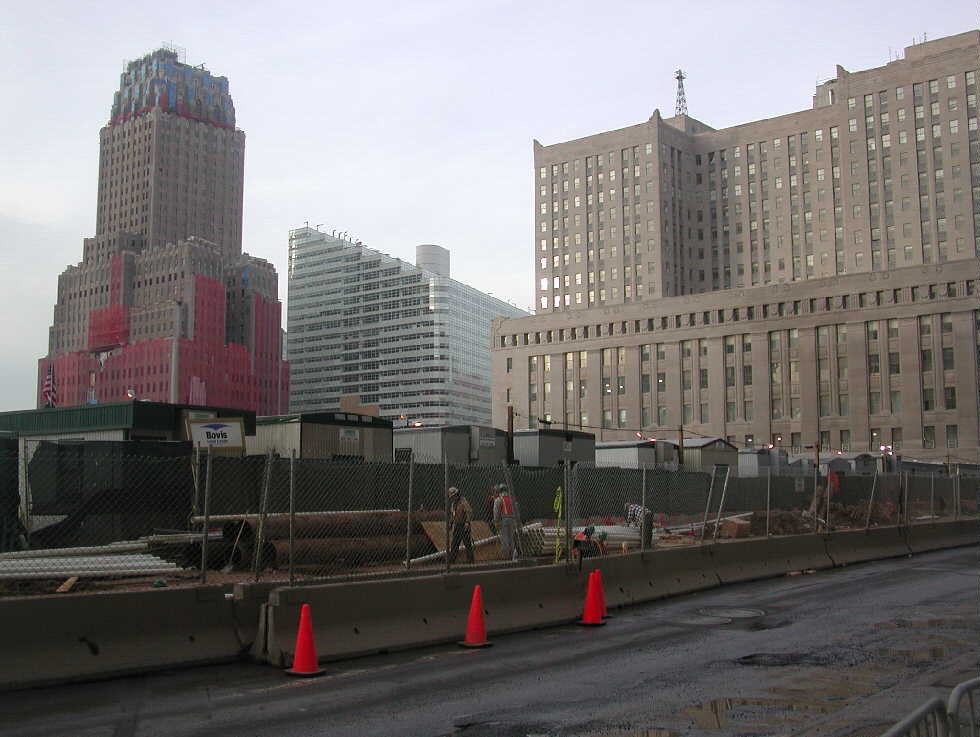
Temporary construction trailers along WTC site excavation, opposite observation platform across Church Street, looking northwest.
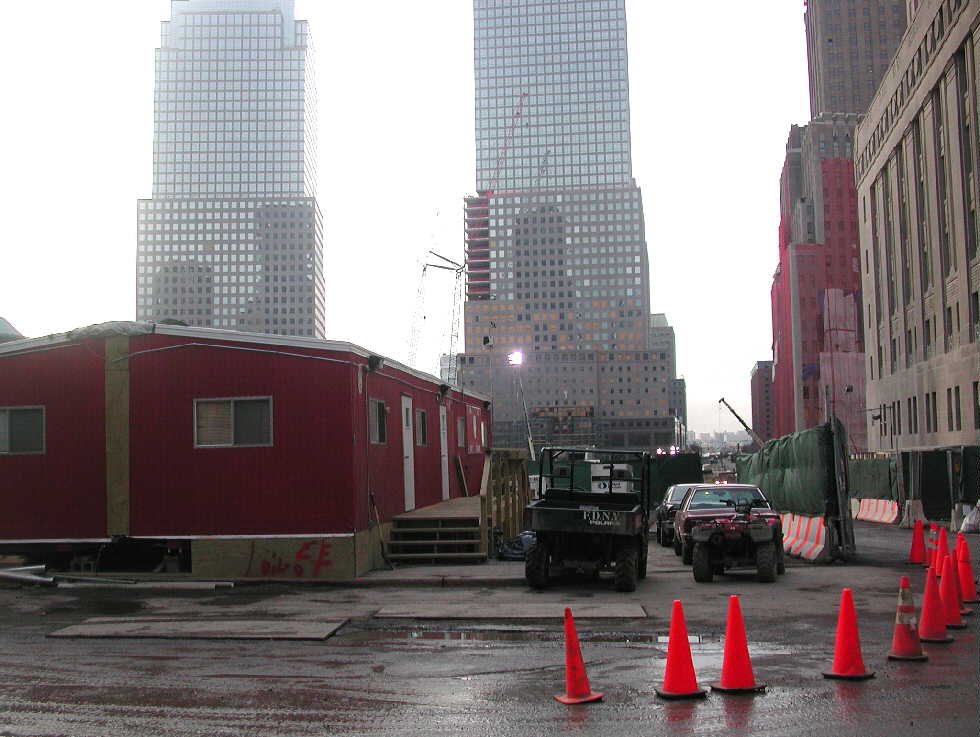
Fire Department temporary facility, WTC site, corner of Church and Vesey Streets; American Express tower in World Financial Center in background, looking west.

4 March 2002. Photo from the west side of the WTC site, looking through gap in protective fence; in the center distance is the red NY Fire Department trailer at the corner of Church and Vesey Street, shown in the photo above. Additional construction trailers are at a level below the street level, adjacent to the WTC pit. Formwork for a new concrete wall can be seen in the middle distance, its purpose unknown.

Wintergarden Pavilion at World Financial Center with exterior glazing being rebuilt; American Express tower at right.
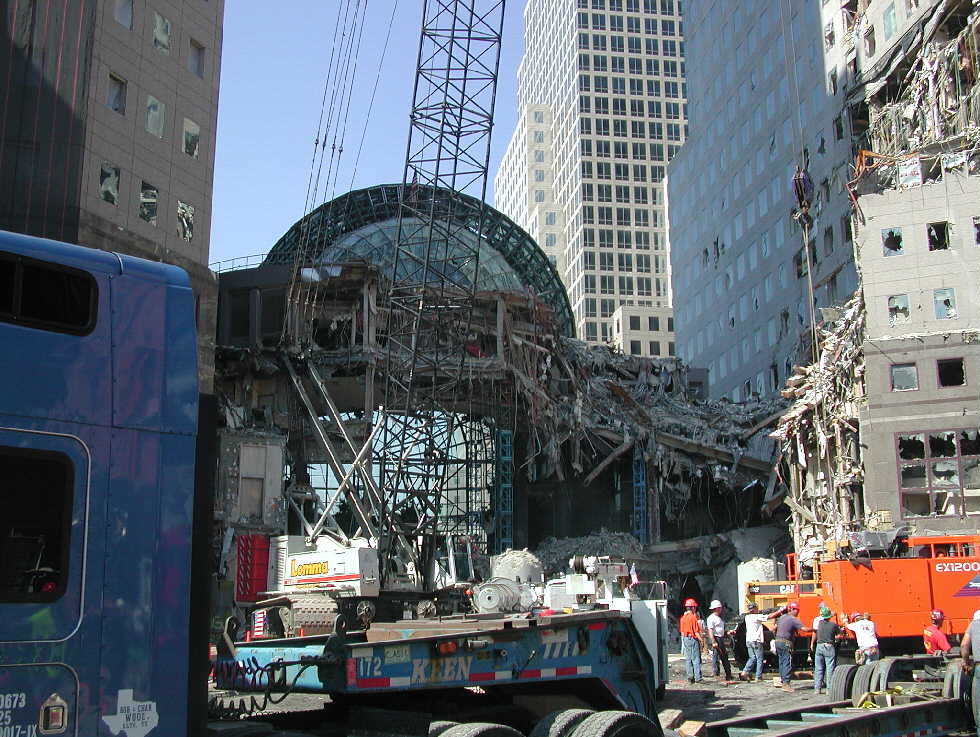
3 October 2001. Wintergarden Pavilion.
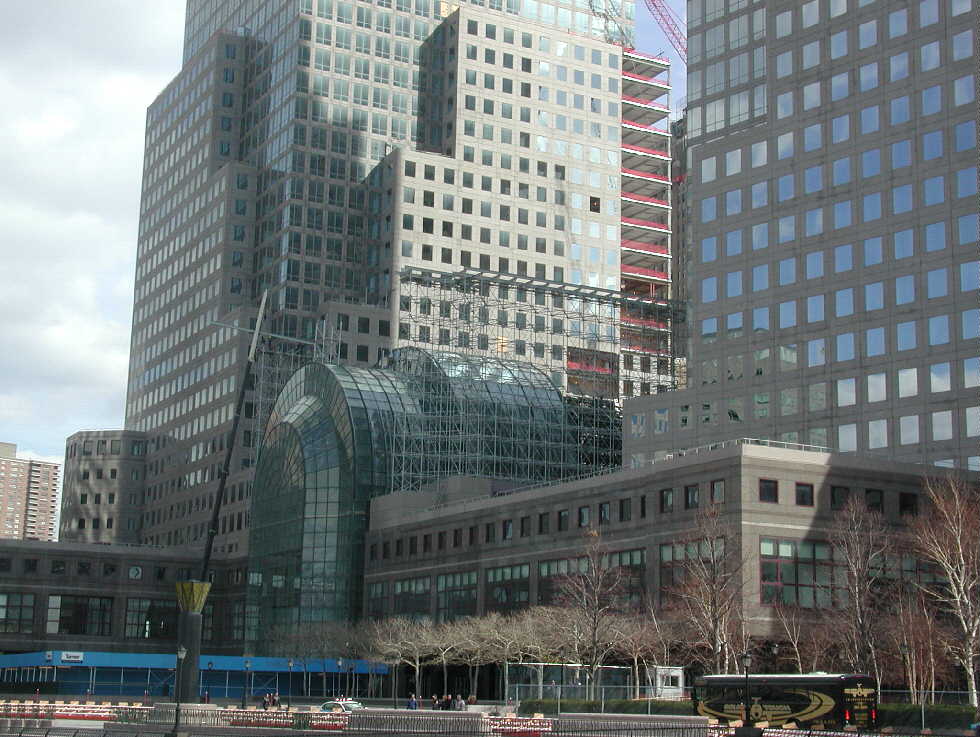
4 March 2002. Wintergarden Pavilion from the west, opposite the view above. American Express building behind the pavilion.
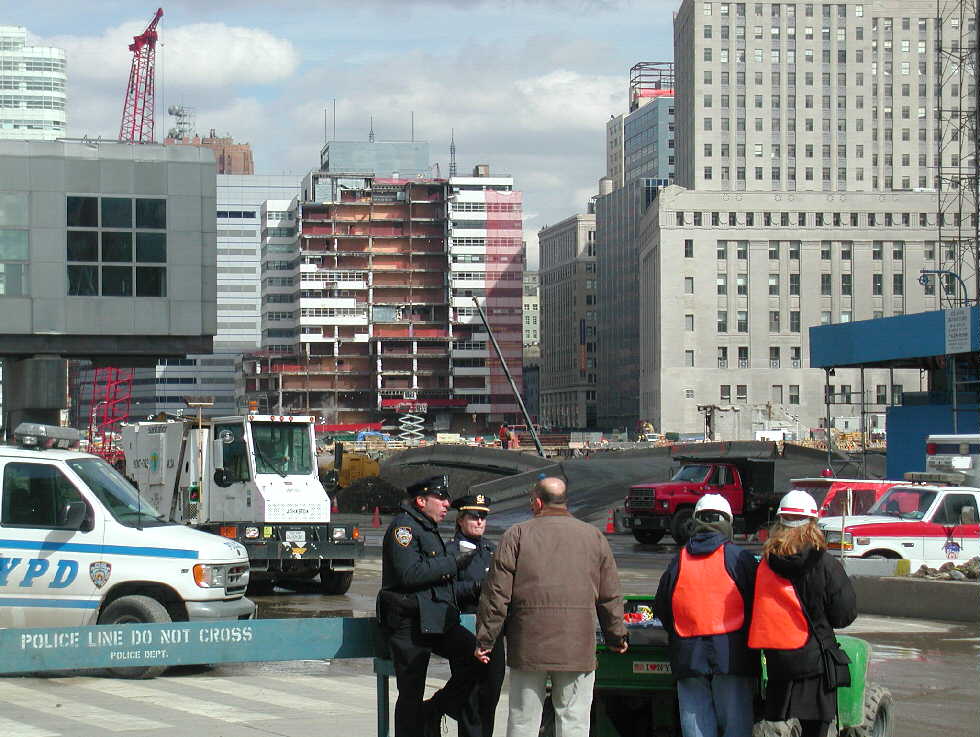
4 March 2002. Borough of Manhattan Community College building in the center distance under repair; damaged by collpase of WTC 7, looking north from West Street. In the middle foreground is one of several temporary ramps constructed into the WTC pit for excavation.
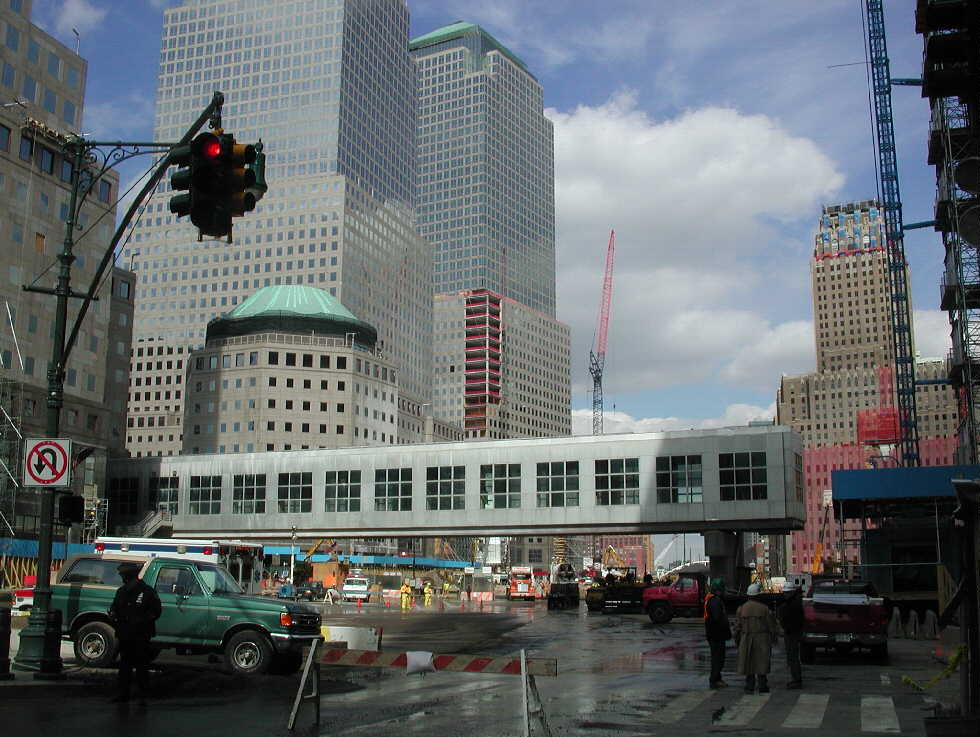
4 March 2002. View of World Financial Center 9wfc) from south. The South Bridge in the foreground that once connected WFC to WTC.
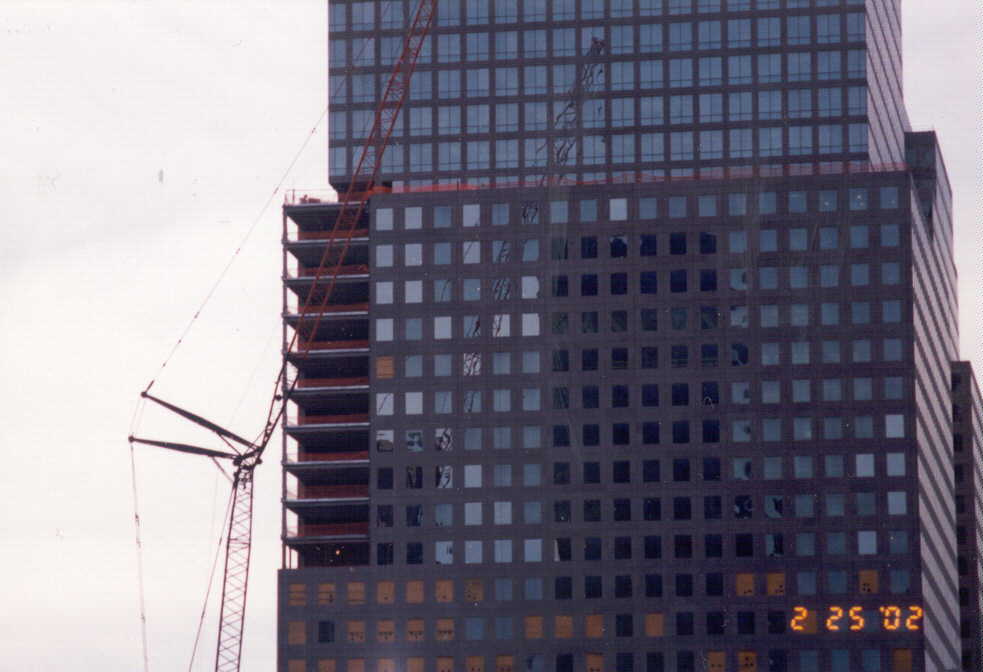
American Express tower in World Financial Center, showing crushed corner being rebuilt.
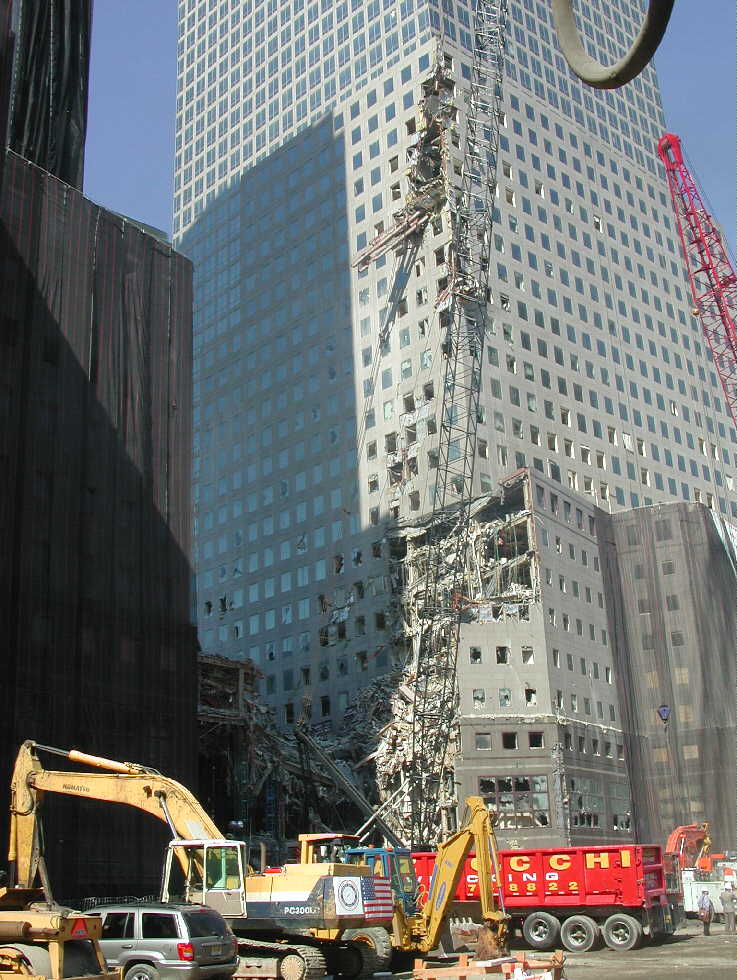
3 October 2001. American Express tower.
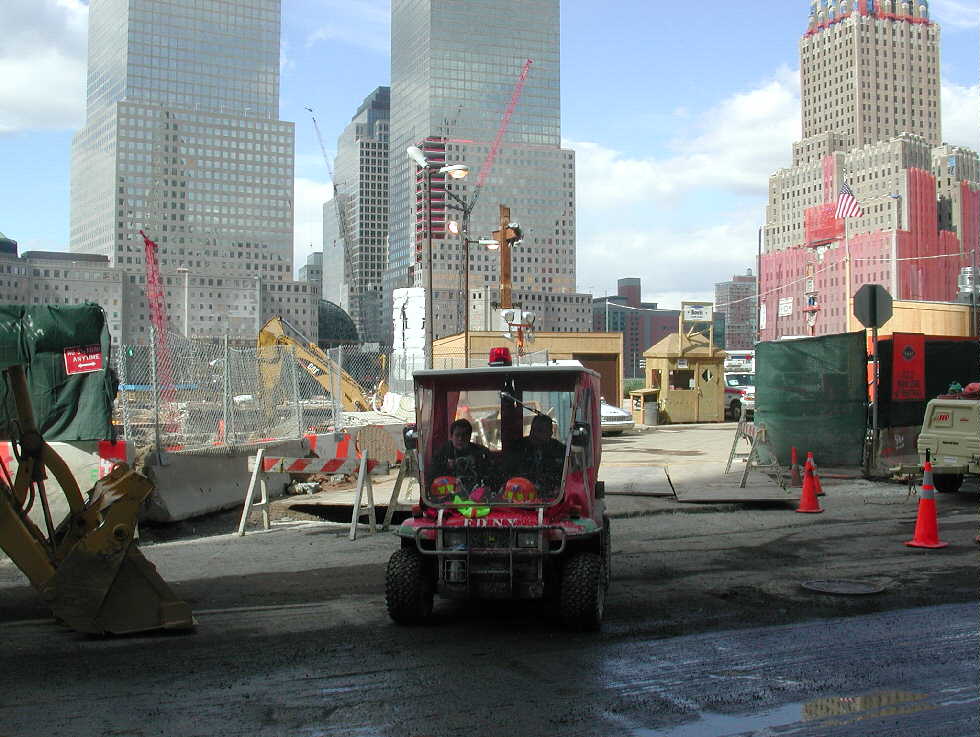
4 March 2002. Entrance to WTC recovery and construction site, from Church Street looking west. At the center is the celebrated steel cross, a fragment of WTC structure.
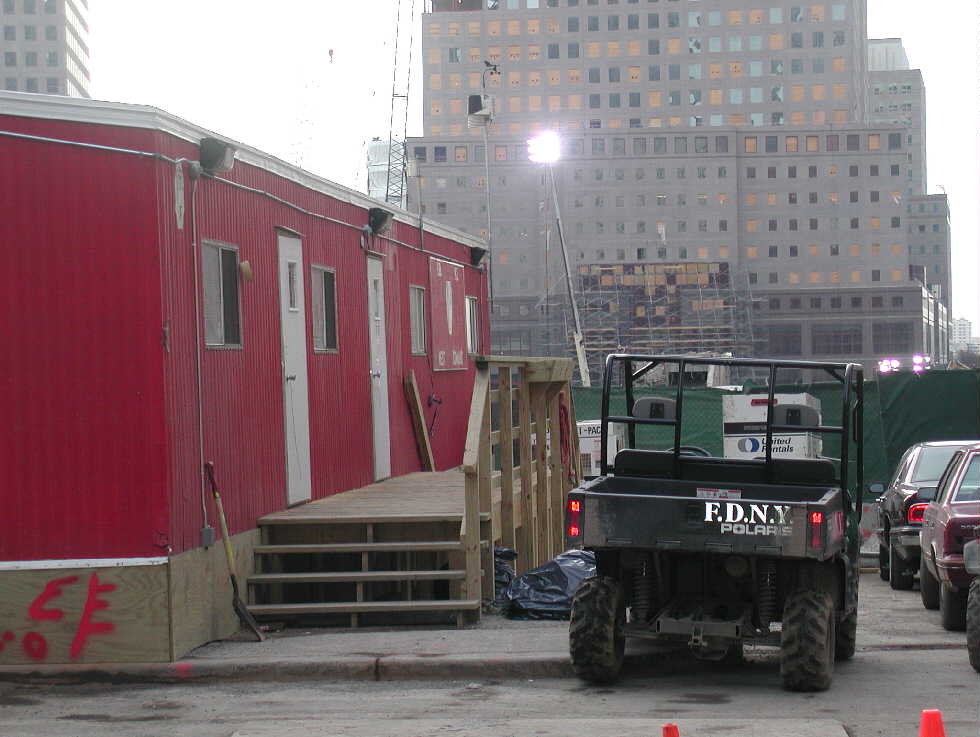
Fire Department temporary facility, WTC site, corner of Church and Vesey Streets; American Express tower in World Financial Center in background, looking west.
Photographs of the WTC site, 3 October 2001: http://nunce.org/wtc/wtc-photos.htm
Photographs of Fresh Kills, 25 January 2002, site for investigation of human remains and WTC debris: http://nunce.org/wtc-fk/wtc-freshkills.htm